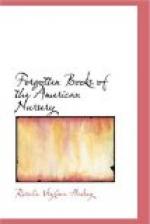There was also the novel of letters. In the age of the first great novelists letter-writing was among the polite arts. It was therefore counted a great but natural achievement when the epistolary method of revealing the plot was introduced. “Clarissa Harlowe” and “Sir Charles Grandison” were the results of this style of writing; they comprehended the “most Important Concerns of private life”—“concerns” which moved with lingering and emotional persistency towards the inevitable catastrophe in “Clarissa,” and the happy issue out of the misunderstandings and misadventures which resulted in Miss Byron’s alliance with Sir Charles.
Until after the next (nineteenth) century had passed its first decade these tales were read in full or abridged forms by many children among the fashionable and literary sets in England and America. Indeed, the art of writing for children was so unknown that often attempts to produce child-like “histories” for them resulted in little other than novels upon an abridged scale.
But before even abridged novels found their way into juvenile favor, it was “customary in Richardson’s time to read his novels aloud in the family circle. When some pathetic passage was reached the members of the family would retire to separate apartments to weep; and after composing themselves, they would return to the fireside to have the reading proceed. It was reported to Richardson, that, on one of these occasions, ’an amiable little boy sobbed as if his sides would burst and resolved to mind his books that he might be able to read Pamela through without stopping.’ That there might be something in the family novel expressly for children, Richardson sometimes stepped aside from the main narrative to tell them a moral tale."[80-A]
Mr. Cross gives an example of this which, shorn of its decoration, was the tale of two little boys and two little girls, who never told fibs, who were never rude and noisy, mischievous or quarrelsome; who always said their prayers when going to bed, and therefore became fine ladies and gentlemen.




